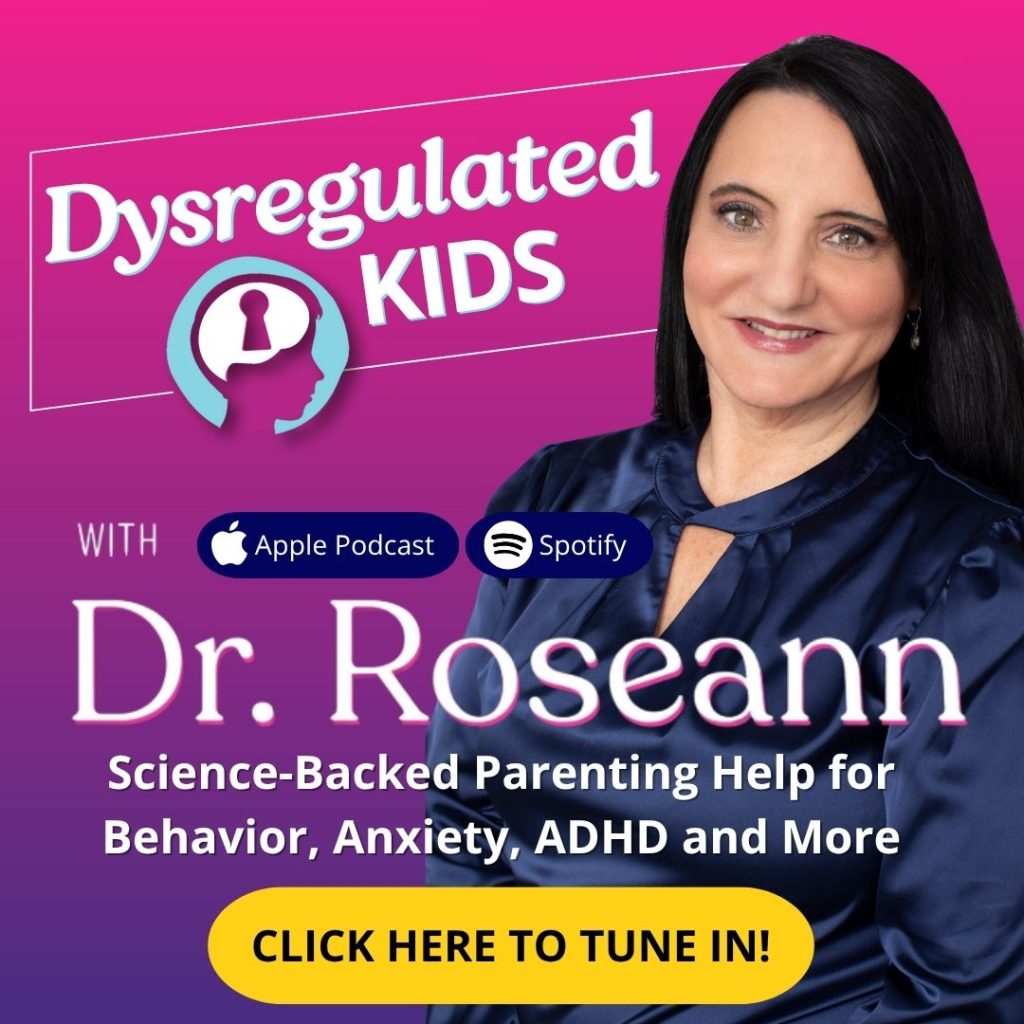Estimated reading time: 7 minutes
Many parents feel like they’ve tried everything—from reward charts to discipline systems—only to end up exhausted and discouraged. And the truth? Strategies don’t work until the brain is calm.
This guide shares science-backed positive parenting solutions rooted in neuroscience and compassion to help you move from reacting to regulating—so you can build lasting calm and connection at home.
What Are Positive Parenting Solutions and Why Do They Matter?
Positive parenting solutions focus on connection, regulation, and empathy—not punishment or control. When the brain feels calm and safe, real learning and cooperation can begin.
These approaches help you:
- Guide behavior without shame or fear
- Strengthen emotional connection so your child feels seen and secure
- Build lasting regulation and resilience from the inside out
That’s the heart of Regulation First Parenting™—my framework built on Regulate → Connect → Correct™.
How Does Positive Parenting Differ From Traditional Discipline?

Traditional discipline focuses on behavior—time-outs, consequences, or rewards—without addressing what’s really driving it: the nervous system behind the behavior. In contrast, positive parenting recognizes that behavior is communication from a dysregulated brain (Kahhalé, Barry, & Hanson, 2023).
Traditional approach | Positive parenting |
Corrects behavior through punishment or incentives | Calms the brain first, connects emotionally, then corrects behavior |
This shift doesn’t excuse poor behavior—it helps your child’s brain access self-control so that real change can stick.
What Are the Core Principles of Positive Parenting Solutions?

Positive parenting teaches—it doesn’t punish. It’s about shaping behavior through calm and connection. When you calm the brain first, cooperation naturally follows.
Key principles:
- Regulate first. Help your child’s nervous system settle—breathe together, move, or share a quick laugh.
- Connect emotionally. Validation builds trust. Saying, “I get that you’re upset” tells your child their feelings matter.
- Correct calmly. Once calm and connected, set limits with empathy. Think bumpers in a bowling lane—firm but guiding.
- Model regulation. Kids absorb our calm faster than our words. Your energy sets the tone.
- Focus on solutions. Swap “What’s wrong with you?” for “What do you need right now to feel safe?”
Parenting isn’t about perfection—it’s about progress. Regulate → Connect → Correct™—that’s the rhythm of Regulation First Parenting™. Because behavior isn’t defiance; it’s communication from a brain that needs calm.
How Can Parents Apply Positive Parenting at Home?
Real change grows from small, steady steps. Begin with your own calm—peace moves through a family like a quiet wave. When you steady your breath, your child’s brain begins to match your rhythm.
Try this:
- Take slow, deep breaths or offer gentle touch during meltdowns
- Keep routines steady to help your child feel safe
- Practice co-regulation—your calm anchors theirs
- Create a cozy space with sensory tools for comfort
- Praise effort: “I love how you kept trying.”
When we reinforce progress instead of perfection, we build confidence and resilience. Research by Burt et al. (2024) shows that children grow into the energy we model—and calm parenting truly creates calm kids.
Parent Story:
Celia, a mom of a 9-year-old with anxiety, once dreaded bedtime battles. When she replaced threats with calm breathing and gentle cues, those stressful nights turned into moments of connection.
Regulate first, and your child will mirror your calm. Connection and cooperation naturally follow.
How Can Positive Parenting Help With Behavior Problems?
Behavior is communication—every meltdown says, “I don’t feel safe.”
When you focus on regulation first, you move from punishment toward understanding. That’s how Positive Parenting gradually rewires behavior for lasting change.
|
Behavior You See |
What’s Really Happening |
Positive Parenting Response |
|
Meltdown over transitions |
Nervous system overload |
Offer choices, use visual schedule |
|
Defiance or talking back |
Power struggle = fear |
Lower your voice, state clear limit |
|
Avoiding tasks |
Anxiety or overwhelm |
Break task into smaller steps |
|
Aggression or shouting |
Fight/flight response |
Co-regulate, model calm breathing |
How Does Positive Parenting Work for Dysregulated or Neurodivergent Kids?
or kids with ADHD, anxiety, mood issues, OCD, ASD, or PANS/PANDAS, discipline often backfires if the brain is overstressed.
That’s why the Regulation First Parenting™ framework starts with the nervous system.
When the brain feels safe:
- Focus improves
- Emotional control strengthens
- Problem-solving becomes possible
How Can I Stay Calm When My Child Is Dysregulated?
It starts with co-regulation—that quiet superpower you already have. Your calm nervous system becomes your child’s anchor when waves of emotion start to rise. Kids borrow your calm before they can build their own.
Try this mini-reset:
- Pause before responding.
- Take a slow breath in through the nose and out through the mouth.
- Ground yourself by feeling your feet on the floor.
- Speak softly: “You’re safe. I’m here to help.”
Your energy teaches safety. When you stay regulated, you show your child what calm looks and feels like.
Parent Story:
Marcus, a dad of a 7-year-old with ADHD, began using a “pause and breathe” rule before reacting to outbursts. Over time, his son started copying his calm breathing—proof that kids learn regulation through modeling.
Takeaway: Your nervous system sets the tone for your home.
Practical Positive Parenting Strategies That Work
Here are small shifts that spark big change. Think of them as brain-calming habits—steady steps that build safety, structure, and trust.
- Set clear limits
Consistency soothes kids like sunlight steadies a plant. Firm yet kind boundaries signal safety and predictability.
- Swap punishment for problem-solving
Say, “Let’s pause and cool off, then talk.” That small shift turns conflict into connection and learning.
- Use natural consequences
If your child forgets homework, let the experience teach while you stay supportive. Real-life lessons stick deeper than lectures.
- Praise effort, not perfection
Highlight persistence or self-regulation: “You kept trying even when it felt hard.” Effort builds resilience and confidence.
- Add sensory regulation tools
Movement, deep pressure, or slow breathing reset an overloaded brain. Calm the brain first—and everything else follows.
How Can I Stay Consistent When I’m Exhausted or Overwhelmed?
You’re human—and exhausted doesn’t mean you’re failing. It means your nervous system needs regulation too.
Try this quick RESET to Regulate Routine:
- Reset your breath — 4-count inhale, 6-count exhale
- Express empathy — “You’re having a hard time, not giving me a hard time.”
- Stay close — proximity soothes
- Engage gently — simple, calm words
- Teach after calm returns
The softer your tone, the faster the regulation.
How Can I Foster Cooperation Without Yelling or Threats?
Yelling might get quick results, but it cracks connection and safety—the very foundation kids need for regulation.
Try instead:
- Lower your voice when theirs rises
- Offer two choices: “Brush before or after pajamas?”
- Use visual schedules to build predictability
- Pause before starting discipline talks
Parent Story:
Samantha, a teacher and mom of two, noticed her son shut down whenever she raised her voice. By whispering instead of yelling, she diffused power struggles and watched cooperation rise.
When we calm the brain first, everything follows—focus, cooperation, and connection. Positive Parenting Solutions aren’t about perfection; they’re about understanding that behavior is communication and that calm is the doorway to change.
Parent Action Steps
- Cultivate an environment where the child feels comfortable sharing thoughts and feelings.
- Actively listen and show empathy to build a strong parent-child connection.
- Set firm but kind limits for your child.
- Offer simple choices to reduce power struggles.
- Keep routines steady and predictable.
- Use co-regulation tools like breathing or gentle touch.
- Take our Solution Matcher to get science-backed solutions to help your child today.
FAQs
Is Positive Parenting the same as permissive parenting?
No—Positive Parenting combines empathy with structure. It’s warm, not weak. You stay kind and consistent while guiding behavior with connection, not control.
Can positive parenting work with strong-willed kids?
Yes. It’s actually ideal for them. Positive parenting helps soothe their reactive nervous system, rebuilds trust, and creates the safety they need to listen and learn.
What’s the biggest mistake parents make with positive parenting?
Skipping regulation. Connection can’t happen until calm returns. A dysregulated brain simply can’t learn or cooperate.
What if my partner doesn’t use the same approach?
Do what you can with your own energy. Even one calm, grounded parent can shift the tone of the whole home.
Can positive parenting be combined with therapy or medication?
Absolutely. When the nervous system settles, therapy and medication work more effectively—because calm brains can finally absorb support.
Citations
Burt, S. A., Shewark, E. A., Shero, J., Pearson, A. L., Neiderhiser, J. M., Klump, K. L., & Lonstein, J. S. (2024). Child effects on positive parenting vary with neighborhood opportunity. Developmental Psychology, 60(5), 878–890. https://doi.org/10.1037/dev0001738
Kahhalé, I., Barry, K. R., & Hanson, J. L. (2023). Positive parenting moderates associations between childhood stress and corticolimbic structure. PNAS nexus, 2(6), pgad145. https://doi.org/10.1093/pnasnexus/pgad145
Dr. Roseann is a mental health expert in Neurodivergence who is frequently in the media:
- Business Insider How to practice ‘autonomy-supported parenting’ to boost your family’s wellbeing
- Healthline Get Stuff Done: A Realistic Guide to Working From Home with Kids
- Life’s Essential Ingredients Reconnecting at the Root
Always remember… “Calm Brain, Happy Family™”
Disclaimer: This article is not intended to give health advice and it is recommended to consult with a physician before beginning any new wellness regime. *The effectiveness of diagnosis and treatment vary by patient and condition. Dr. Roseann Capanna-Hodge, LLC does not guarantee certain results.
Are you looking for SOLUTIONS for your struggling child or teen?
Dr. Roseann and her team are all about science-backed solutions, so you are in the right place!
©Roseann Capanna-Hodge











